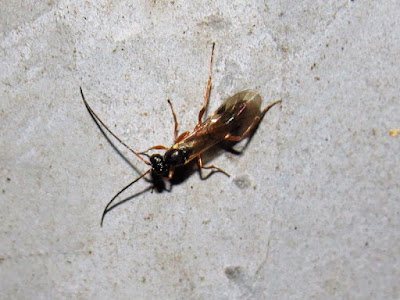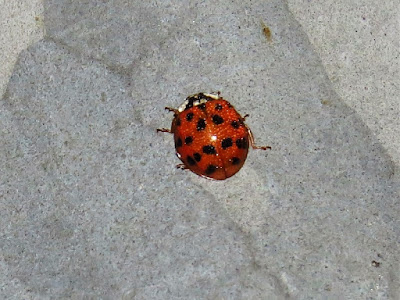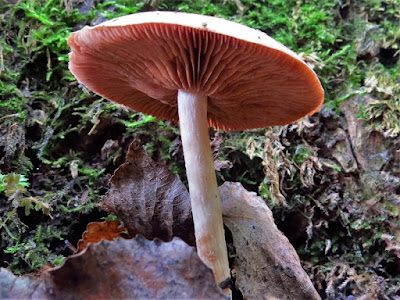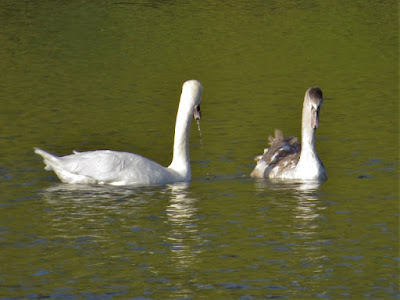Priorslee Lake and The Flash13.0°C > 14.0°C: Mostly cloudy once more. Light drizzle c.08:00. Fresh / strong S wind. Very mild again. Very good visibility.
Sunrise: 07:58 BST
*= a photo today
Priorslee Lake: 06:25 – 09:25
(243rd visit of the year)
Rather quiet on the lake. I wonder whether the construction work across Castle Farm Way is having an effect. Earth-moving equipment has created a large mound of soil which is being added to from c.07:15 by vehicles with very powerful lights. These shine across much of the lake. Next week, after the clocks have changed, work will not start until after day-break for a few weeks at least.
Other bird notes:
- I was correct when I suspected the two Mute Swans might not be 'our' pair. One has blue Darvic ring 7JVC; the other has neither a Darvic plastic nor BTO metal ring.
- Only one pair of Gadwall seen. Still an extra drake.
- Five Black-headed Gulls arrived at 07:20 but did not stay. No more until c.20 at 07:35 with eventually a rush of over 150 arriving together at 07:45.
- This morning's early 'large gull' count: 11 Lesser Black-backed Gulls and one Herring Gull stopped off; and 39 unidentified gulls flew over.
- As I was trying to count the first big group of >80 Jackdaws passing over the E end of the lake at least 80 Starlings shot out of the reeds at that end and mingled with them.
- A lone Reed Bunting was the only other bird noted leaving a roost around the water.
Overhead:
- 27 Wood Pigeons: no migrant groups
- 48 Lesser Black-backed Gulls
- 39 unidentified large
gulls only
- 1 Common Buzzard again
- >200 Jackdaws
- 1 Rook
- c.20 Pied Wagtails
- 1 Siskin
Warblers noted:
- 1 Cetti's Warbler: sang at least five times in the NW area
Count from the lake area:
- *2 Mute Swans [yesterday's total should have read 2 also]
- 2 (1♂) Mallard: departed
- 3 (2♂) Gadwall [yesterday's total should have read 5 (3♂)]
- *1 (0♂) Pochard again
- 42 (>21♂) Tufted Duck
- no Moorhens seen or heard: most unusual
- 52 Coots
- 1 Little Grebe
- c.175 Black-headed Gulls
- 4 Herring Gulls
- 27 Lesser Black-backed Gulls
- 1 Grey Heron: departed
At / around the street lamps pre-dawn:
Draughty again!
Moths:
- 2 November Moth agg. (
Epirrita sp.)
with:
- several more small flies
- *possible
Pegomya bicolor- *
Phaonia pallida- *unidentified
- *1 ichneumon sp.
- 2 Common European Earwig (
Forficula dentata)
- 2 Pogonognathellus longicornis-type springtail
- *1 possible Iris Leaf Beetle (
Aphthona nonstriata)
- 1
Larinioides cornutus (Orb-web spider)
- 1 Bridge Orb-web Spider (
Larinioides sclopetarius)
Feedback via Martin Adlam from the Diptera Facebook group suggests from yesterday
- the small fly with the startlingly red eyes is probably a species of
Drosophila fly. This group are called small fruit, wine or vinegar flies. One member,
D. melanogaster is widely used in science. It seems that the genes of these flies and of humans are so closely related (!) the flies can be used in genetic research.
- the larger fly with red eyes and red-brown head and thorax is almost certainly
Dryomyza anilis.
Wikipedia will provide more details than you could ever wish to know about these critters.
Noted later:
- 2 more species of fungus
- - *probable Hare's-foot Inkcap (
Coprinopsis lagopus)
- *Beefsteak Fungus (
Fistulina hepatica)
Some Autumn colour. The leaves were rapidly falling in the strong wind.
The magic camera just about froze the movement of the leg on this Mute Swan to enable the Darvic ring to be read – 7JVC.
I managed a reasonable photo of the Pochard. Although it looks superficially like a duck Pochard the back looks rather blotchy and the pale mark behind the eye is rather indistinct. I suspect it might be an immature yet to moult in to adult plumage, though I would think it will become a duck anyway.
One of a three different small flies this morning, this with a grey thorax and red abdomen. It may be a
Pegomya bicolor though the photos of that species on the web do not seem to have the dark bands across the abdomen.
This is almost certainly one of the more common small flies, though slightly larger than some. I think
Phaonia pallida.
Here is another small fly, this with rather dull red eyes and a striped grey / black thorax. I cannot track down any identity for it.
I probably saw the species yesterday though I fouled up the photo. It looks to be a species of ichneumon – the 'wasp-waist' can just be made out. Unlike species I have seen before this appears to have a mark in the wing.
A tiny black beetle found on a lamp pole. It is possible it is an Iris Leaf Beetle (
Aphthona nonstriata), a species associated with Yellow Flag Iris which occurs here. But there are many species of small beetle.
I think this is a Beefsteak Fungus (Fistulina hepatica) on a tree that is broken off just above head height.
Another fine clump of fungus.
A closer view of one of them. I am sure this one of the Coprinus group, known colloquially as Inkcaps.
One small one still growing showing their original shape. The group most closely resembles
Coprinopsis lagopus, known as the Hare's-foot Inkcap from the supposed resemblance of the young fruiting bodies to the foot of a Hare. While not being entirely familiar with the Hare's anatomy this one does not look like the foot of anything. [Confused of Newport: the scientific name for the Hare family is
Lepus. It is the Grouse family that is
Lagopus. So why not
C. lepus?]
I tried to get a shot of the underside. I could find no angle that was not against the sky and even forcing the flash to fire failed to provide the detail I hoped for. The fruits of this species are very short-lived – they deliquesce in a matter of hours. The underground mycelium live for many years.
(Ed Wilson)
------------------------------------------------------------------------------------------------------
The Flash: 09:30 – 10:10
(220th visit of the year)
Bird notes:
- The two Mute Swan cygnets went for a fly seemingly untroubled by the brisk wind. I have only seen them within the confines of the water.
- The drake Teal apparently on its own again.
- A single call from a Chiffchaff enabled me to find it gleaning insects from trees at the top of squirrel alley.
- Two Redwings seen leaving the island.
Birds noted flying over here:
None
Warblers noted:
- 1 Chiffchaff
On /around the water:
- 30 Canada Geese
- 3 + 2 (1 brood) Mute Swan
- 39 (26♂) Mallard
- 1 (1♂) Teal again
- 14 (4♂) Tufted Duck
- 9 Moorhens only
- 23 Coots
- 3 Great Crested Grebes again
- 51 Black-headed Gulls
- no Grey Herons
On a lamp pole:
- 1
Dicranopalpus ramosus-type harvestman again
Noted elsewhere:
- A few Common Wasps (
Paravespula vulgaris) on the Ivy flowers braving the windy conditions.
- 1 Grey Squirrel
(Ed Wilson)
------------------------------------------------------------------------------------------------------
On this day can be found via the yearly links in the right-hand column.
Sightings from previous years without links are below
2010
Priorslee Lake
c.75 Starlings left roost at W end
118 Wood Pigeons
2 Skylarks
7 Meadow Pipits
478 Fieldfare
76 Redwings
9 Siskins
13 Linnets
1 Redpoll
(Ed Wilson)
2006
Priorslee Lake
1 Little Grebe
2 Cormorants
26 Pochard
47 Tufted Ducks
1 drake Ruddy Duck
1 Water Rail
64 Coots
35 Fieldfares
3 Song Thrushes
24 Redwings
4 Mistle Thrushes
(Ed Wilson)
2005
Priorslee Lake
2 Little Grebes
Wigeon
Cormorant
300 Black-headed Gulls
40 Lesser Black-backed Gulls
c.75 Lapwings
2 Fieldfares
1 duck Pochard
34 Tufted Duck
200 Coot
(Ed Wilson)

























































